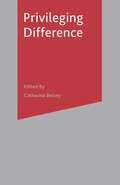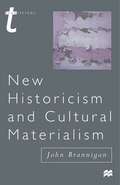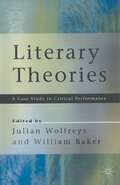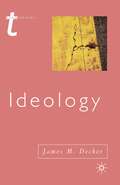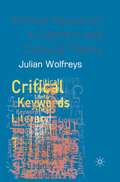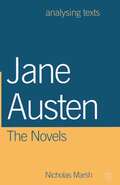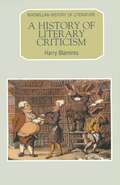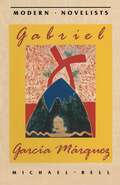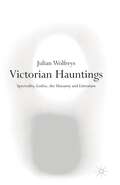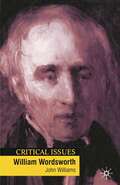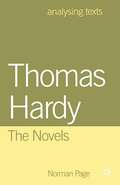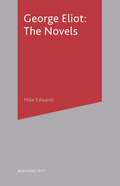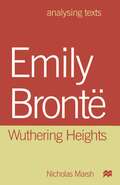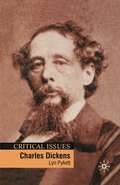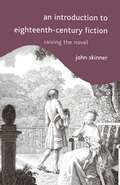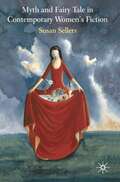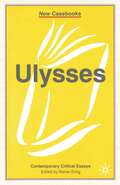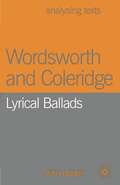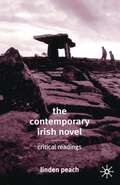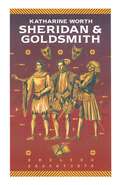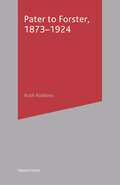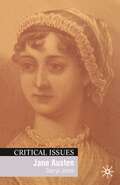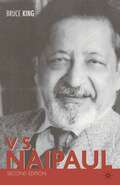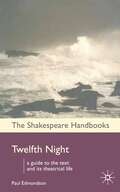- Table View
- List View
Privileging Difference
by Antony EasthopeDifference, the key term in deconstruction, has broken free of its rigorous philosophical context in the work of Jacques Derrida, and turned into an excuse for doing theory the easy way. Celebrating variety for its own sake, Antony Easthope argues, cultural criticism too readily ignores the role of the text itself in addressing the desire of the reader. With characteristic directness, he takes to task the foremost theorists of the current generation one by one, including Edward Said and Homi Bhabha, Dona Haraway, Rosi Braidotti and Judith Butler. In a final tour de force, he contrasts what he calls the two Jakes, Jacques Lacan and Jacques Derrida, to bring out the way their respective theories need each other. The book is vintage Easthope: wide-ranging, fearless, witty and a radical challenge to complacency wherever it is to be found.
New Historicism and Cultural Materialism (Transitions)
by John BranniganNew historicism and cultural materialism emerged in the early 1980s as prominent literary theories and came to represent a revival of interest in history and in historicising literature. Their proponents rejected both formalist criticism and earlier attempts to read literature in its historical context and defined new ways of thinking about literature in relation to history. This study explains the development of these theories and demonstrates both their uses and weaknesses as critical practices. The potential future direction for the theories is explored and the controversial debates about their validity in literary studies are discussed.
Literary Theories: A Case Study in Critical Performance
by William Baker Julian WolfreysEvery student of literature needs to understand how to use literary theory to analyse and interpret the text. Literary Theories challenges the out-dated notion that theory is something separable from the act of reading and interpretation and, believing that the best way to learn is through practical application, plunges the student into the midst of a range of critical readings. Clearly argued and lucidly written, these essays offer the student reader an interactive introduction to the ways in which contemporary literary theories challenge us to rethink interpretation, literary writing and critical reading.
Ideology (Transitions)
by James DeckerThis concise introduction to the concept of ideology provides an overview of the term and considers its impact on literary theory. James M. Decker analyzes the history of Western ideology from its pre-Enlightenment roots to its current incarnations, providing readers with both an essential overview of key terms and issues and a thoughtful assessment of some of the important critical thinkers associated with the notion, including Marx, Gramsci and Althusser.Ideological theories are introduced within three broad categories - the subjective, the institutional and the political - which helps students to synthesize a concept that sprawls across the traditional disciplinary lines of philosophy, politics, economics, history and cultural and literary studies.Close readings of key texts demonstrate the impact of ideology on critical practice and literary reputation. Texts include: - Toni Morrison's Sula - William Faulkner's 'Barn Burning' - George Orwell's 1984Compact and easy-to-follow, Decker's study finally asks: are we now in a 'post-ideological' era?
Critical Keywords in Literary and Cultural Theory
by Julian WolfreysThis book is an invaluable reference guide for students of literary and cultural studies which introduces over forty of the complex terms, motifs and concepts in literary and cultural theory today.Critical Keywords in Literary and Cultural Theory- Gives students a brief introduction to each concept together with short quotations from the work of key thinkers and critics to stimulate discussion and guide genuine comprehension- Supplies helpful glosses and annotations for each term, concept or keyword which is discussed- Offers reflective, practical questions at the end of each entry to direct the student to consider a particular aspect of the quotations and the concept they address- Provides explanatory notes and bibliographies to aid further researchThis essential volume is ideal as both a dip-in reference book and a guide to literary theory for practical classroom use.
Jane Austen: The Novels (Analysing Texts)
by Nicholas MarshJane Austen's novels are among the most polished and carefully-crafted works in the English literary heritage. This book takes extracts and examines them in close detail, bringing out the extraordinary richness of irony and implication in Jane Austen's writing. Using the tool of textual analysis, the reader is taught to explore and enjoy the delicate comedy of her narratives, and to inquire into the serious moral purpose that lies behind each of these four novels. This guide does not simplify the study of Jane Austen, but invites the reader to pursue and revel in the ironic subtlety of her methods and thought.
A History of Literary Criticism (Macmillan History of Literature)
by Harry BlamiresThe author traces the course of literary criticism from its foundations in classical and medieval precepts to the theorising of the present day. He explores the texts which have been milestones in the history of critical thought, placing them firmly in the context of their time.
Gabriel García Márquez: Solitude and Solidarity (Modern Novelists)
by Michael BellMuch good criticism of Mrquez came in the wake of One Hundred Years of Solitude and the perception of his fiction has been dominated by that novel. It seemed the implicit goal to which the earlier fiction has been striving. By concentrating on the later novels, including The General in his Labyrinth, this study brings out the internal dialogue between the novels so that One Hundred Years of Solitude then stands out, like Don Quixote in Cervantes' oeuvre, as untypical yet more deeply representative. Behind the popular impact of its 'magical realism' lies Mrquez' abiding meditation on the nature of fictional and historical truth.
Victorian Hauntings: Spectrality, Gothic, the Uncanny and Literature
by Julian WolfreysVictorian Hauntings asks its reader to consider the following questions:What does it mean to read or write with ghosts, or to suggest that acts of reading or writing are haunted? In what ways can authors in the nineteenth century be read so as to acknowledge the various phantom effects which return within their texts? In what ways do the traces of such "ghost writing" surface in the works of Dickens, Tennyson, Eliot and Hardy? How does the work of spectrality, revenance and the uncanny transform materially both the forms of the literary in the Victorian era and our reception of it today? Beginning with an expoloration of matters of haunting, the uncanny, the gothic and the spectral, Julian Wolfreys traces the ghostly resonances at work in Victorian writing and how such persistence addresses isues of memory and responsibility which haunt the work of reading.'Taking the familiar genre of the Gothic as a point of departure and revisiting it through Derridean theory, Wolfreys' book, the first application of "hauntology" to the domain of Victorian Studies is a remarkable achievement. Wolfreys never reduces reading to instrumentality but remains alert to all the potentialities of the texts he reads with a great attention to their idiosyncrasies. Victorian Hauntings should bring a new tone to Victorian Studies, this clever book is quite perfect.' - Jean Michel Rabate, Professor of English, University of Pennsylvania'You'd have to be dead to know more about ghosts than Julian Wolfreys.' - Martin McQuillan, University of Leeds
William Wordsworth (Critical Issues)
by John WilliamsFrom the earliest reviews of his poetry, readers were deeply divided on the merits of William Wordsworth's work. John Williams looks in detail at the major poems and discusses the critical issues that have dominated discussions of Wordsworth's compositions since they first began to appear in print after 1798.Beginning with a fresh assessment of the controversies that developed around Lyrical Ballads, the chapters trace the evolution of both Wordsworth's poetry and his reputation through to his death in 1850. At each stage, Williams investigates the possible reasons why critics and readers responded as they did: enraged by his revolutionary 'Jacobinism' at the turn of the eighteenth century; insulted by the 'simplicity' of the Poems in Two Volumes of 1807; reassured by his commitment to Nature and his reverence for Church and State in the early Victorian period.In the twentieth century, Wordsworth has been subjected to a series of extensive critical reappraisals. With reference to a wide range of the poetry, Williams goes on to discuss the way Wordsworth has been variously reconstructed as a consequence of the main critical and theoretical initiatives of the last one hundred years. He also examines the Wordsworth we have inherited for the twenty-first century: a poet many still feel has important things to say to the contemporary reader about human relationships, nature, the environment, and our imaginative life.
Thomas Hardy: The Novels (Analysing Texts)
by Norman PageThis book is designed to serve as a practical guide for students and others wishing to improve their skills in the detailed analysis and discussion of Hardy's prose texts. Its aim is to sharpen readers' awareness of the complexity and subtlety of Hardy's art by encouraging responsiveness to such aspects as language and style, imagery and symbol, descriptive and dramatic method and narrative technique. At the same time extracts are considered not in isolation but in relation to the overall purposes of a highly-organised text.While the main focus is on four of Hardy's most-widely read novels, the twenty-four examples of close analysis cover six major themes that are relevant to all his fiction. There are also numerous references to his other writings in prose and verse. The second part of the book provides, in succinct form, essential background material, including an outline of Hardy's life and career and an account of the literary, historical and intellectual contexts of his fiction. As well as a guide to further reading, a chapter is devoted to samples of criticism illustrating a range of approaches to the chosen texts and representing the work of important critics past and present.
George Eliot: The Novels (Analysing Texts)
by Mike EdwardsThis volume guides students through Eliot's most widely studied novels: The Mill on the Floss, Silas Marner and Middlemarch. The first part of the book is based on analysis of extracts grouped by themes including relationships, society and morality. At the end of each chapter, a 'Methods' section offers ideas for independent study. The second part describes Eliot's biographical, cultural and intellectual environment, and gives readings of representative critical writing.
Emily Bronte: Wuthering Heights (Analysing Texts)
by Nicholas MarshChapters on the narrative frame, characters, imagery and symbols, structure and themes use practical analysis to build and refine our insight into Wuthering Heights. Part Two gives information about Emily Brontë's life and works, a discussion of this novel's place in the development of fiction and a comparison of three important critical views. Suggestions for further reading, fully explained examples of analysis and suggestions for further work make this volume both accessible and a bridge to further study.
Charles Dickens (Critical Issues)
by Lyn PykettTo many of his contemporaries, Charles Dickens was the greatest writer of his age; a one-man fiction industry who produced fourteen massive novels, and numerous sketches, essays and stories, many of which appeared in the two magazines which he founded and edited. Today the work of one of the first and most successful mass-circulation authors continues to enthrall readers around the world.This wide-ranging book examines the writings of Dickens, not only in his time but also in ours. It looks at the author as a Victorian 'man of letters', and explores his cultural and critical impact both on the definition of the novel in the nineteenth century and the subsequent development of the form in the twentieth. Lyn Pykett focuses on Dickens as journalist, literary entrepreneur, the conductor of magazines, the shaper of the serial novel, the manipulator of the multiple plot, and the creator of eccentric characters. She also assesses the modernity of the writer's alienated protagonists and their social environments, as well as reassessing his representations of the vivid, bleak and at times menacing spectacle of the metropolis, from the late modern/postmodern perspective of the twenty first century.Each chapter of this text analyses the work of a particular decade in Dickens's career, providing a lively contextual study which places his writings in relation to the worlds that made him, and the literary worlds which he made. It is essential reading for all those with an interest in one of the most popular, and enduring, British novelists of all time.
An Introduction to Eighteenth-Century Fiction: Raising the Novel
by John SkinnerThe formal and expressive range of canonic eighteenth-century fiction is enourmous: between them Defoe, Richardson, Fielding, Smollett and Sterne seem to have anticipated just about every question confronting the modern novelist; and Aphra Behn even raises a number of issues overlooked by her male successors. But one might also reverse the coin: much of what is present in these writers will today seem remote and bizarre. There is, in fact, only one novelist from the 'long' eighteenth century who is not an endangered species outside the protectorates of university English departments: Jane Austen. Plenty of people read her, moreover, without the need for secondary literature. These reservations were taken into account in the writing of this book.An Introduction to Eighteenth Century Fiction is a comprehensive and accessible introduction to English fiction from Aphra Behn to Jane Austen. It deals with novel criticism, canon formation and relations between genre and gender. The second part of the book contains an extensive discussion of Richardson and Fielding, followed by paired readings of major eighteenth-century novels, juxtaposing texts by Behn and Defoe, Sterne and Smollett, Lennox and Burney among others. The various sections of the book, and even the individual chapters, may be read independently or in any order. Works are discussed in a way intended to help students who have not read them, and even engage with some who never will. The author consumes eighteenth-century fiction avidly, but has tried to write a reader-friendly survey for those who may not.
Myth and Fairy Tale in Contemporary Women's Fiction
by Susan SellersWoman as gorgon, woman as temptress: the classical and biblical mythology which has dominated Western thinking defines women in a variety of patriarchally encoded roles. This study addresses the surprising persistence of mythical influence in contemporary fiction. Opening with the question 'what is myth?', the first section provides a wide-ranging review of mythography. It traces how myths have been perceived and interpreted by such commentators as Sigmund Freud, Carl Jung, Bruno Bettelheim, Roland Barthes, Jack Zipes and Marina Warner. This leads to an examination of the role that mythic narrative plays in social and self formation, drawing on the literary, feminist and psychoanalytic theories of Julia Kristeva, Luce Irigaray, Helene Cixous and Judith Butler to delineate the ways in which women's mythos can transcend the limitations of logos and give rise to potent new models for individual and cultural regeneration.In this light, Susan Sellers offers challenging new readings of a wide range of contemporary women's fiction, including works by A. S. Byatt, Angela Carter, Anne Rice, Michele Roberts, Emma Tennant and Fay Weldon. Topics explored include fairy tale as erotic fiction, new religious writing, vampires and gender-bending, mythic mothers, genre fiction, the still-persuasive paradigm of feminine beauty, and the radical potential of comedy.
Ulysses (New Casebooks)
by Rainer EmigThis collection of recent essays on James Joyce's masterpiece, Ulysses, provides an up-to-date overview of debates in Joycean scholarship, with particular emphasis on gender, postcolonial and ideological critiques, and deconstructive readings. The essays are framed by an introduction that assesses particularity and universal schemes in Joyce's novel, including its role in modern literature.
Wordsworth and Coleridge: Lyrical Ballads (Analysing Texts)
by John BladesWritten in an age of revolutions, Lyrical Ballads represents a radical new way of thinking - not only about literature but also about our fundamental perceptions of the world. The poetry of Wordsworth and Coleridge continues to be among the most appealing and challenging in the rich tradition of English Literature; and Lyrical Ballads, composed at the height of the young authors' creative powers, is now widely acclaimed as a landmark in literary history.In this lively study, detailed analysis of individual poems is closely grounded in the literary, political and historical contexts in which Lyrical Ballads was first conceived, realised and subsequently expanded into two volumes. John Blades examines poetry from both volumes and carefully reassesses the poems in the light of Wordsworth's and Coleridge's revolutionary theories, while Part II of the study broadens the discussion by tracing the critical history of Lyrical Ballads over the two centuries since its first publication.Providing students with the critical and analytical skills with which to approach the poems, and offering guidance on further study, this stimulating book is essential reading.
The Contemporary Irish Novel: Critical Readings
by Linden PeachThis essential guide offers innovative critical readings of key contemporary novels from Ireland and Northern Ireland. Linden Peach discusses texts that are representative of the richness of Irish writing during the 1980s and 1990s, and reads works by established authors alongside those by the new generation of writers. The novels examined include works by John Banville, Jennifer Johnston, Roddy Doyle, Emma Donoghue, Seamus Deane, William Trevor, Dermot Bolger, Joseph O'Connor, Patrick McCabe, Mary Morrissy, Glenn Patterson and Robert McLiam Wilson.The Contemporary Irish Novel addresses themes such as ghosts and haunting, mimicry, obedience and subversion, the relocation and reinscription of identity, the mother figure, parent-child relations, madness, masculinity, self-harm, sexuality, domestic violence, fetishism and postmodernity. Drawing on a range of critical approaches including postcolonial, gender and psychoanalytic theory, Peach explores and celebrates the diversity of Irish fiction and suggests that the boundary between literature and theory is as permeable as that between Ireland and Northern Ireland.
Sheridan and Goldsmith (English Dramatists)
by Katharine WorthEach generation needs to be introduced to the culture and great works of the past and to reinterpret them in its own ways. This series re-examines the important English dramatists of earlier centuries in the light of new information, ew interests and new attitudes. The books will be relevant to those interested in literatire, theatre and cultural history, and to threatre-goers and general readers who want an up-to-date view of these dramatists and their plays, with the emphasis on performance and relevant culture history.This book explores the reasons for the deep and lasting appeal of Sheridan's and Goldsmith's comedies, showing how they operate at the profound imaginative level and draw on their author's experience as Irish wits in an English scene. Their subtle dramatic techniques are examined in relation to physical features of the eighteenth-century stage. A chapter on sentimental comedy relates to plays such as Hugh Kelly's False Delicacy to the balance of irony and sentiment in Goldsmith's The Good Natur'd Man and Sheridan's A Trip to Scarborough. The continuing freshness of the comedy of mistakes, masks and Harlequin-like role playing which the two playwrights draw from the operatic and theatrical conventions of their day is illustrated from modern productions. These have helped to illuminate the psychological truth and social awareness underlying the sparkling surfaces of Sheridan's and Goldsmith's classic comedies.
Pope to Burney, 1714-1779: Scriblerians to Bluestockings (Transitions)
by Moyra HaslettThis essential guide defines literature of the eighteenth century as a literature written and received as public conversation. Moyra Haslett discusses and challenges conventional ways of reading the period, particularly in relation to notions of the public sphere. In her wide-ranging study, Haslett reads key texts - including The Dunciad, Gulliver's Travels and Pamela - in their literary and cultural contexts, and examines such genres as the periodical, the familiar letter, the verse epistle and the novel as textual equivalents of coterie culture.
Pater to Forster, 1873-1924 (Transitions)
by Ruth RobbinsWas the late nineteenth century 'Victorian' or 'modern'? Why did the New Woman disappear from literary history? Where did T. S. Eliot's poetics of the city come from?In this essential guide, Ruth Robbins explores an era often named an 'age of transition' which exists uneasily between the apparent certainties of the Victorians and the advent of a Modernist aesthetics of instability. Robbins considers some of the central literary categories and themes of the period (decadence, realism, nostalgia, New Woman writing, degeneration, imperialism and early modernism) in writings by both major and 'minor' writers, thereby creating a complex picture of transitions, continuities and breaks with the past. By examining this tumultuous era as an age in its own right, Pater to Forster, 1873-1924 offers the reader a rather different history of the late Victorians and Modernists, and retells that history from a new perspective.
Jane Austen (Critical Issues)
by Darryl JonesThis book offers a one-volume study of Jane Austen that is both a sophisticated critical introduction and a valuable contribution to the study of one of the most popular and enduring British novelists. Darryl Jones provides students with a coherent overview of Austen's work and an idea of the current state of critical debate.
V.S. Naipaul
by Bruce KingV. S. Naipaul is a reader-friendly introduction to the writing of one of the most influential contemporary authors and the 2001 Nobel laureate in Literature. Bruce King provides a novel by novel analysis of the fiction with attention to structure, significance, and Naipaul's development as a writer, while setting the texts in their autobiographical. philosophical, social, political, colonial and postcolonial contexts. King shows how Naipaul modified Western and Indian literary traditions for the West Indies and then the wider world to become an international writer whose subject matter includes the Caribbean, England, India, Africa, the United States, Argentina, and contemporary Islam.Thoroughly revised and updated, the second edition of V. S. Naipaul now includes an expanded Introduction, and discussion of his most recent novels A Way in the World and Half a Life, his Nobel Lecture, Naipaul's writings on Islam, and a survey of the main criticism by other writers and postcolonial theorists.
Twelfth Night (Shakespeare Handbooks)
by Paul EdmondsonThis book opens up Twelfth Night as a play to see and hear, provides useful contextual and source material, and considers the critical and theatrical reception over four centuries. A detailed performance commentary brings to life the many moods of Shakespeare's subtle but robust humour. Students are encouraged to imagine the theatrical challenges of Shakespeare's Illyria afresh for themselves, as well as the thought, creative responses and wonder it has provoked.
